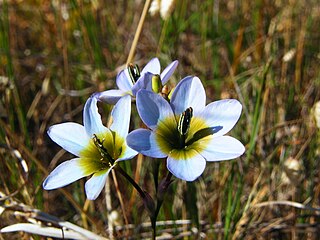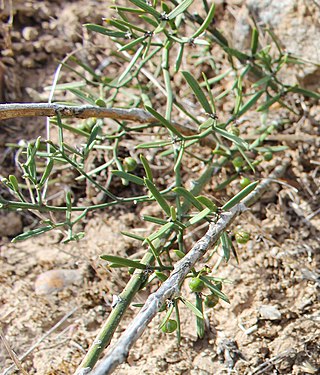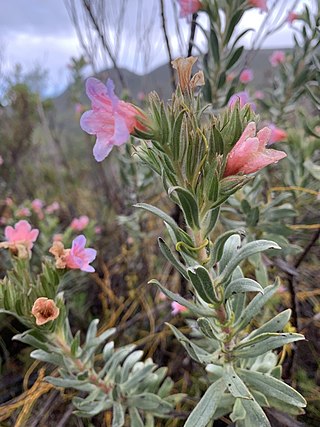
Disa bracteata, also known as the bract disa, leek orchid or the South African weed orchid is a species of orchid native to South Africa.

Baeometra is a genus in the family Colchicaceae containing a single species, Baeometra uniflora. It is native to South Africa, where it is commonly called beetle lily due to the dark markings on the tepals.

Ixia monadelpha, also known as the pied kalossie or bontkalossie, is an endangered species of geophyte found in wet sandy flats in the southwestern Cape of South Africa.

Acrodon is a genus of ice plants from South Africa. It comprises five species, mostly endangered and all restricted to the southern Cape regions of the Western Cape and Eastern Cape Provinces, South Africa.

Drimia exuviata ("Gifbol") is a species of flowering plant in the family Asparagaceae, subfamily Scilloideae, indigenous to the south-western parts of South Africa.

Macledium spinosum is a variable species of flowering plant in the family Asteraceae, that is endemic to the southern Cape regions of South Africa.
Aspalathus millefolia is a species of Aspalathus shrub, which occurs in the Overberg region of the Western Cape Province, South Africa.

Asparagus striatus ("Bergappel") is a hard perennial shrublet of the Asparagus genus, that is indigenous to dry, rocky areas of South Africa.
Asparagus burchellii, is a shrub of the Asparagus genus, that is indigenous to dry scrub vegetion in the southern Cape region, South Africa.
Ruschia leptocalyx is a species of succulent plant in the family Aizoaceae. It is endemic to South Africa, where its natural habitat is in rocky renosterveld vegetation in the southern Cape.

Lobostemon belliformis, the Gouriqua lobostemon or beaut healthbush, is a critically endangered species in the forget-me-not family. It is known from a single locality on the Riversdale Plain in South Africa.

Lobostemon capitatus is a species belonging to the forget-me-not family. It is endemic to the Western Cape of South Africa, where it is found between Porterville and Bredasdorp.

Lobostemon curvifolius, the largeflower healthbush, is a species of the forget-me-not family from South Africa.
Lobostemon daltonii, the Infanta healthbush, is a species of the forget-me-not family endemic to South Africa.

Dianthus albens is a species of flowering plant in the family Caryophyllaceae.
Dianthus bolusii, called the mountain pink or bergangelier, is a species of flowering plant in the family Caryophyllaceae.

Acrodon bellidiflorus, the common tiptoothfig, is a mesemb species from South Africa.
Acrodon deminutus, also known as the Malgas tiptoothfig, is a species of mesemb from South Africa.
Acrodon caespitosus, the Potberg tiptoothfig, is a species of mesemb from South Africa.
Acrodon subulatus, the Overberg tiptoothfig, is a species of mesemb from South Africa.










